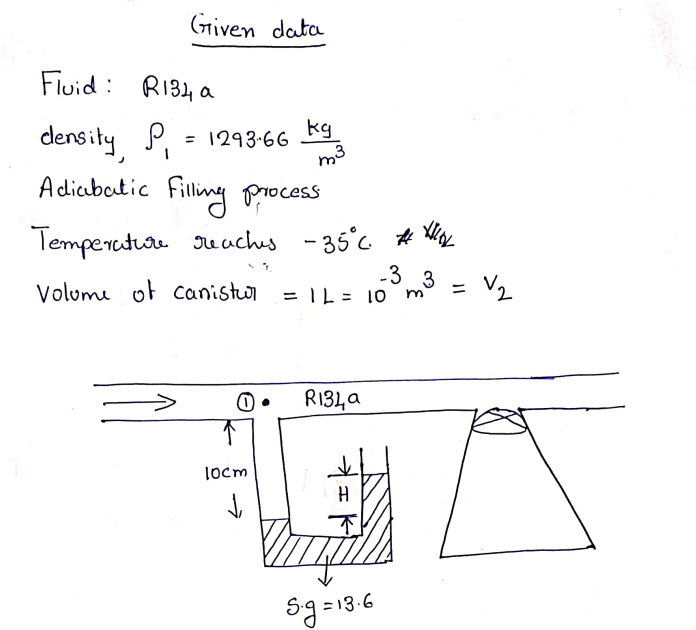An empty Jiter canster is filled with Ri34 a from a line flowins seturated unh fhe temperature innde he poressure cof The flow. he fillins mted to be adubatic, be Plserdennty ir 1d00 Ks/3 and Arcuning 2. a If the manumeter ir uhhzing a with a specafil granty of 13,6, uhat i5 H b Mow much mass of RB4a enters he Canioter duning ne filling? SWe leave Dhe aanirter fu adJust otor tempereture to the roum temperature cf 20°C hat d)Mow much heat crokser he buundarjer of fhe canister dureng part Ce) ? Canister
An empty Jiter canster is filled with Ri34 a from a line flowins seturated unh fhe temperature innde he poressure cof The flow. he fillins mted to be adubatic, be Plserdennty ir 1d00 Ks/3 and Arcuning 2. a If the manumeter ir uhhzing a with a specafil granty of 13,6, uhat i5 H b Mow much mass of RB4a enters he Canioter duning ne filling? SWe leave Dhe aanirter fu adJust otor tempereture to the roum temperature cf 20°C hat d)Mow much heat crokser he buundarjer of fhe canister dureng part Ce) ? Canister
Elements Of Electromagnetics
7th Edition
ISBN:9780190698614
Author:Sadiku, Matthew N. O.
Publisher:Sadiku, Matthew N. O.
ChapterMA: Math Assessment
Section: Chapter Questions
Problem 1.1MA
Related questions
Question
100%

Transcribed Image Text:**Educational Content on Filling a Canister with Fluid R134a**
This document contains a problem related to thermodynamics and fluid mechanics, focusing on filling an empty canister with R134a, a refrigerant.
### Problem Statement:
1. **Filling an Empty Canister:**
- An empty filter canister is being filled with R134a from a line whose standard conditions are \( R134a \) flowing at 233.66 kg/m\(^3\) and a pressure of 700 kPa.
- The mass flow rate during the filling is measured to be 2 kg/min.
- Determine the specific volume of the R134a if the immediate density of the fluid becomes 343 kg/m\(^3\).
2. **Use of a Manometer:**
- Consider an orifice plate attachment connected to a manometer.
- The manometer uses a fluid with a specific gravity of 1.56.
- Calculate the final pressure inside the canister, given a manometer reading of 0.21 m.
3. **Mass of R134a:**
- Calculate the total mass of R134a that enters the canister during the filling process.
4. **Temperature and Pressure Adjustments:**
- The canister is allowed to reach a uniform temperature of 20°C.
- Determine the final pressure in the canister under this condition.
5. **Heat Transfer:**
- Assess how much heat crossed the boundary of the canister during the filling.
### Diagram and Explanation:
- **Diagram:**
- There is a simple schematic of a canister being filled with fluid R134a.
- An arrow indicates the direction of R134a flow into the canister.
- A section showing a manometer placed vertically with a measurement denoted as "10 cm."
- **Explanation:**
- The diagram illustrates the filling process and instrumentation which are part of this thermodynamic system. The focus on measuring parameters like pressure and mass flow is crucial for understanding fluid dynamics in practical applications such as refrigeration systems.
This educational material is aimed at aiding students in understanding the principles of fluid dynamics, pressure measurement, and thermodynamics in the context of handling refrigerants.
Expert Solution
Step 1
Since you have asked for multiple subparts, we have answered the first three subparts. Kindly repost the question and mention the subparts to be answered

Step by step
Solved in 2 steps with 4 images

Recommended textbooks for you

Elements Of Electromagnetics
Mechanical Engineering
ISBN:
9780190698614
Author:
Sadiku, Matthew N. O.
Publisher:
Oxford University Press

Mechanics of Materials (10th Edition)
Mechanical Engineering
ISBN:
9780134319650
Author:
Russell C. Hibbeler
Publisher:
PEARSON

Thermodynamics: An Engineering Approach
Mechanical Engineering
ISBN:
9781259822674
Author:
Yunus A. Cengel Dr., Michael A. Boles
Publisher:
McGraw-Hill Education

Elements Of Electromagnetics
Mechanical Engineering
ISBN:
9780190698614
Author:
Sadiku, Matthew N. O.
Publisher:
Oxford University Press

Mechanics of Materials (10th Edition)
Mechanical Engineering
ISBN:
9780134319650
Author:
Russell C. Hibbeler
Publisher:
PEARSON

Thermodynamics: An Engineering Approach
Mechanical Engineering
ISBN:
9781259822674
Author:
Yunus A. Cengel Dr., Michael A. Boles
Publisher:
McGraw-Hill Education

Control Systems Engineering
Mechanical Engineering
ISBN:
9781118170519
Author:
Norman S. Nise
Publisher:
WILEY

Mechanics of Materials (MindTap Course List)
Mechanical Engineering
ISBN:
9781337093347
Author:
Barry J. Goodno, James M. Gere
Publisher:
Cengage Learning

Engineering Mechanics: Statics
Mechanical Engineering
ISBN:
9781118807330
Author:
James L. Meriam, L. G. Kraige, J. N. Bolton
Publisher:
WILEY